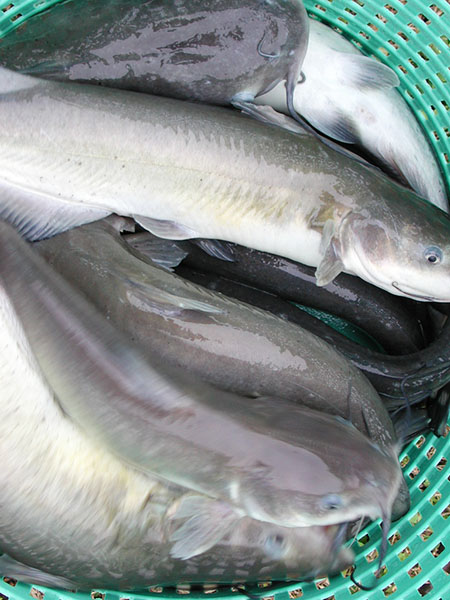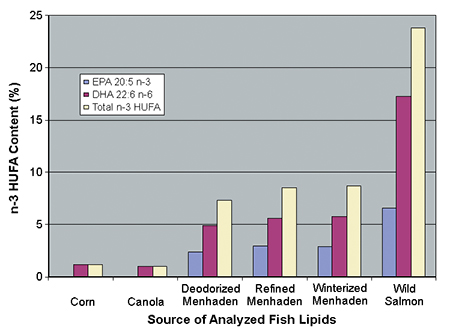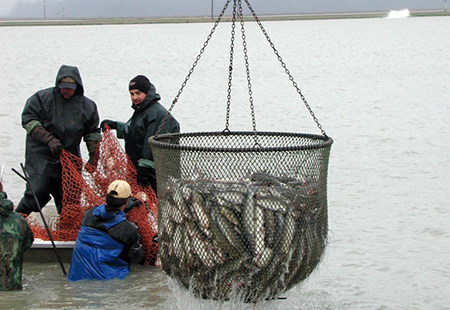Development of an enriched catfish product could offer consumers a unique value-added food

Recent interest in the nutritional benefits of omega-3 highly unsaturated fatty acids (omega-3 HUFA) has promoted the development of foods that contain higher concentrations of these essential fatty acids. Modern diets for most people, however, are based on foods from animals produced under agricultural systems that rely heavily on grains and oil seeds that are high in the other group of fatty acids, omega-6 (omega-6).
As a consequence, our diets provide a preponderance of omega-6 fatty acids like linoleic acid and arachidonic acid, and relatively little omega-3 fatty acids like alpha linolenic acid, eicosapentaenoic acid (EPA), and docosahexaenoic acid (DHA). In fact, the omega-6:omega-3 ratio of many Americans’ diets may be as high as 20:1, when a more desirable ratio would be about 5:1.
Direct consumption
The most efficient means to obtain adequate amounts of omega-3 HUFA is by direct consumption of foods that are high in these beneficial fatty acids. In 2000, the American Heart Association published guidelines that suggested the twice-weekly consumption of fatty fish that are high in omega-3 HUFA, such as salmon, mackerel, and sardines.
Modifying aquafeeds
Recent research studies conducted at the Thad Cochran National Warmwater Aquaculture Center (NWAC) in Stoneville, Mississippi, USA, indicated that the diet of farm-raised channel catfish (Ictalurus punctatus) can be modified to produce catfish fillets with higher levels of omega-3 HUFA.
Menhaden oil
This was accomplished by including 4 percent by weight of specially refined menhaden fish oils in nutritionally complete wheat-soy meal diets. Menhaden (Brevoortia tyrannus) oil contains approximately 22 to 24 percent omega-3 HUFA (EPA + DHA).
Analysis by gas chromatography of the fillet lipid fraction indicated an elevation of omega-3 HUFA content from a little over 1 percent for corn oil and canola oil up to 8.6 percent for the menhaden oil selections (Fig. 1). These omega-3 HUFA levels were approximately 35 to 36 percent of those found in sea-caught salmon.
Sensory qualities

A taste panel evaluation of the fillets revealed the traditional, mild taste of catfish fillets was not compromised by including menhaden oil in the catfish diets. Although a slight fishy taste was detected in some of the fillets by individual tasters, none of the fillets were considered unacceptable. The alkali-refined menhaden oil selection produced fillets comparable in sensory evaluation to those produced as a result of feeding canola oil.
Additional study
A subsequent 16-week pond study conducted by NWAC at Delta Western Research Center in Indianola, Mississippi, USA compared omega-3 HUFA levels of catfish fillets produced by including 2 or 4 percent alkali-refined menhaden oil in practical corn-soy meal diets. The menhaden oil diets were compared with diets containing 2 or 4 percent catfish offal oil, a typical fat source for commercial catfish feeds. All oils were add-ed to cooled and dried extruded floating pellets by spray application. At termination, fillets were evaluated for omega-3 HUFA level and taste.
Levels of omega-3 HUFA were significantly (P < 0.05) higher for fillets from catfish fed diets containing menhaden oil compared to the fish fed the catfish offal oil diets (Table 1). Sensory evaluation indicated that fillets from catfish fed menhaden oil had satisfactory taste and still retained the desirable mild taste of farm-raised channel cats.
Manning, Levels of n-3 HUFA (EPA + DHA) in channel catfish fillets, Table 1
| Source | Dietary Oil (%) | Dietary Oil (%) | Fillet Fat2 (%) |
|---|
Source | Dietary Oil (%) | Dietary Oil (%) | Fillet Fat2 (%) |
|---|---|---|---|
| Menhaden oil | 2 | 6.38 | 6.87 |
| Menhaden oil | 4 | 6.67 | 7.22 |
| Catfish offal oil | 2 | 2.07 | 7.80 |
| Catfish offal oil | 4 | 3.09 | 8.12 |
Relevance
The significance of a more balanced omega-6:omega-3 ratio is that scientific studies indicate diets with significant amounts of omega-3 HUFA may promote healthier cardiovascular systems, reduce the incidence of thrombotic strokes, and diminish the effects of autoimmune diseases such as rheumatoid arthritis and psoriasis. Additionally, DHA has been shown to be required for normal brain and retinal development in unborn and newborn children. While humans can convert dietary alpha linolenic acid to EPA and DHA, the conversion occurs very slowly.
Conclusion

Currently, there is considerable interest in developing nutrient-enriched foods through ingredient manipulation of animal feeds. Recent studies showed that the addition of menhaden oil to catfish feeds has resulted in fillets with higher levels of omega-3 highly unsaturated fatty acids.
U.S. farm-raised channel catfish provide a healthy, nutritious alternative to red meats and poultry. Development of an omega-3 HUFA-enriched catfish product is seen as a means to offer consumers a unique value-added food. Fillets enriched with omega-3 HUFA could be marketed as a separate and identifiable prepackaged consumer product.
(Editor’s Note: This article was originally published in the April 2002 print edition of the Global Aquaculture Advocate.)
Now that you've finished reading the article ...
… we hope you’ll consider supporting our mission to document the evolution of the global aquaculture industry and share our vast network of contributors’ expansive knowledge every week.
By becoming a Global Seafood Alliance member, you’re ensuring that all of the pre-competitive work we do through member benefits, resources and events can continue. Individual membership costs just $50 a year. GSA individual and corporate members receive complimentary access to a series of GOAL virtual events beginning in April. Join now.
Not a GSA member? Join us.
Authors
-
Bruce Manning, Ph.D.
Thad Cochran National Warmwater Aquaculture Center
Mississippi State University
Stoneville, Mississippi 38776 USA -
Menghe Li, Ph.D.
Thad Cochran National Warmwater Aquaculture Center
Mississippi State University
Stoneville, Mississippi 38776 USA -
Edwin Robinson, Ph.D.
Thad Cochran National Warmwater Aquaculture Center
Mississippi State University
Stoneville, Mississippi 38776 USA
Related Posts

Aquafeeds
Considerations for alternative ingredients in aquafeeds
A key to expanding aquaculture is finding alternative sources of proteins and oils. Supplementing or replacing fish oil in aquaculture feeds with alternative lipid sources – oils seeds, microalgae, insects and others – appears possible as long as essential fatty acid (EFA) requirements are satisfied.

Health & Welfare
Fatty acids in feeds improve growth, lipid profiles of white shrimp farmed at high salinity
A study showed that lipid source and DHA and EPA levels in feeds can influence the growth performance and tail fatty acid profiles of L. vannamei farmed under hypersaline conditions.

Aquafeeds
Lipid, fatty acid requirements of tilapia
Dietary lipids are important sources of energy and the essential fatty acids needed by fish for growth and development.

Health & Welfare
Managing natural productivity in channel catfish nursery ponds
Decisions on stocking channel catfish fry should be based on the abundance of large zooplankton in the pond water, rather than total zooplankton abundance.


